2019 Balkongarten Reflection

Balkongarten in August
I think it’s important to reflect on the successes and failures of the 2019 Balkongarten. Taking a few moments to reflect will help me realize where to focus my efforts next season in order to grow as a gardner. Be sure to take some time to reflect on your growing season or, if you’re new to gardening, imagine what you’d like to accomplish for your first season. Hopefully my reflection will help you avoid some mistakes or inspire you to try something new.
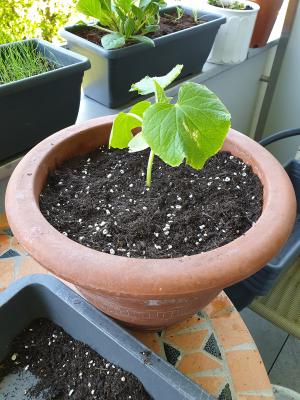
Lemon Cucumber in peat-free potting mix in June
First up is the peat-free potting mix used this year: I really liked it! It kept my plants alive, held up well with minimal compaction, and did not shrink away from the sides of the pot, forcing water to run through the media rather than down the sides and out the bottom. Last year’s attempt at homemade potting mix taught me some hard lessons about which soil media can and cannot be used in containers, so I was overly cautious when trying a new potting media. There was originally no perlite so I added some as a precaution to help the mix stay aerated and retain added moisture. I also added sharp sand and guano for extra drainage and food. Next season I’ll test a few pots without adding perlite, sand, and guano to compare whether the additions were necessary.
One of my least favorite things about gardening, especially container gardening, is watering. It’s a terrible task to dislike because it’s the most important one. I’d rather quickly drench the plant but this isn’t good practice because it can lead to underwatering. But the habit of using the 12 liter watering can to fill the half-liter can and then watering the containers with that has forced me to slow down so water is absorbed properly. This also helps measure out how much water each container requires on a regular basis. For example, I know the 15 liter Tithonia balcony box needed at least one liter of water per day. Chives were in the same size balcony box but only needed about half a liter per day. When you observe the leaves this shouldn’t be a surprise. Tithonia have large flat leaves that are more susceptible to transpiration, water evaporation, verus the long slender leaves of chives. Knowing your plants’ average water requirements helps during those rushed mornings so you can give them the amount they’ll need to survive the day until you can provide the extra care they might need, as well as mitigate water waste.

12 liter and half liter watering can
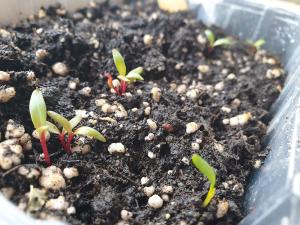
Rainbow chard seedlings
The sowing success of foxglove, kale, alyssum, rainbow swiss chard, cilantro and cosmos really boosted my confidence in starting from seed. All of these plants did better than I expected so I can’t wait to try them again next season. That being said, I need to improve potting-on at the correct time, meaning: potting-on when the plant is ready and not when my schedule is ready. Waiting until I had time stunted some of these plants’ growth, which can attract pests and induce disease.
Other plants that were easy to grow from seed were bell peppers, basil, tomatoes, and chives. None of this is surprising. These plants can take heavy abuse and still provide some harvest. I tried experimenting with the basil as a soil protector or ground cover in the bell pepper and tomato containers. This didn’t exactly work as planned. I planted three peppers in a balcony box and sowed basil seeds around them. The idea was to keep the basil pruned short to shade the potting soil keeping it moist and protected from the elements but having too many plants in one container ended up stunting the peppers growth. I think it would have worked in a larger container but not in these small 15 liter (4 gallon) overhanging pots, or I should have planted fewer basil seedlings, like five, among the peppers.

Basil taking over a bell pepper pot.
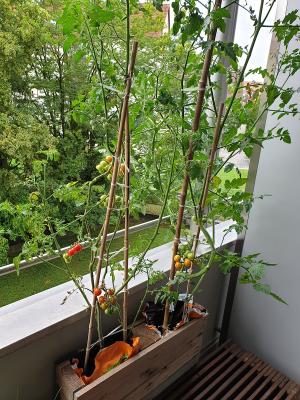
Vining tomatoes in July before they started falling all over the place.
As for the tomatoes, unless you have a way to create a sturdy trellis I do not recommend growing indeterminate vining tomatoes on a balcony. What does indeterminate mean? It’s what you picture most tomatoes as: long, leggy, needs stakes or trellis support. Usually tomatoes vine along the ground rooting wherever their stems make contact with the soil so indeterminate tomatoes keep growing, reaching anywhere between 1.5-3.5m (5-11ft), until frost kills them. Gardeners and farmers stake them to save space and mitigate disease by improving air circulation around the fruit and plant. But indeterminate varieties are not easy to manage in small balcony spaces. Lessons learned from some balcony-garden-loving friends, use determinate bush tomato varieties such as Herztomaten (Heart tomato) and Yellow Balcony Tomato. Bush varieties grow a certain height and stay short and compact, just be sure to get balcony container varieties and/or read what the determinate height is.
I really enjoyed growing some indigo pear tomato seeds I acquired from a friend. They are an interestingly-shaped tomato, almost like green purple jewels hanging from the plant that change to a golden purple when ripe. They are vines but they stayed fairly short for the balcony so I’ll give them another try next season.
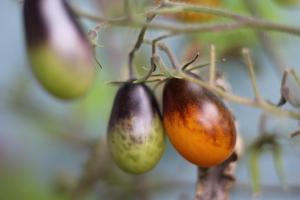
An unripe green indigo pear tomato and a ripe golden indigo pear tomato.
The lemon cucumber did wonderfully on the balcony. This was an extra plant another friend had given me and, to be honest, I was a bit nervous it would get out of control and take over the balcony, but it ended up growing the perfect size for the little container trellis that was used. The striped softball sized cucumbers are tasty and, despite the name, they taste just like a normal cucumber.
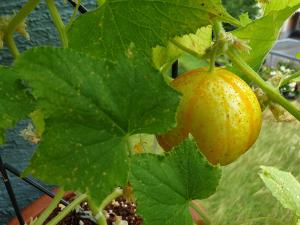
Lemon Cucumber ready for picking
As for all the bell pepper plants, the snack bell peppers did well producing abundant amounts but the normal bell peppers, the ones most commonly sold in supermarkets, didn’t produce much. They produced one to two deformed peppers per plant. I assume this is due to my irregular feeding and not providing them with a large enough pot, as well as overcrowding the pot with basil. The seeds I bought are meant more for a garden rather than containers, so they’ll be used in the Kleingarten next year.
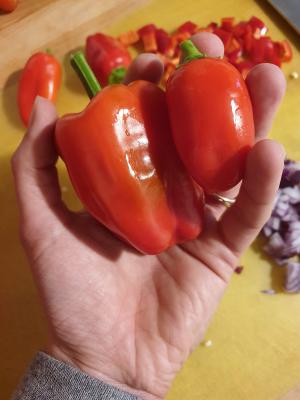
Snack bell peppers from the balcony.
The asters did excellent though they could have been a little healthier. They are perennials and started out as one sad-looking plant in spring that I ended up splitting in half. This must have been the right call because the two halves flourished soon after the split, filling each pot nicely. These plants are eventually destined for the Kleingarten but I haven’t moved them yet, mainly because the area they are going isn’t prepared, and that I’m envious they won’t stay on the balcony. I think I’ll split them again in spring to solve the last issue.
The chives did well. They’ll be transplanted to another pot and left outside over winter until next season. They should produce flowers next year which I’m told are delicious, especially in a creamy dip for bread. I regretted not keeping the 2017-2018 chives for flower production and growth. The plants didn’t look healthy enough to keep but it turns out I should have replanted them into a larger pot. I won’t make the same mistake this time.
I really enjoyed the Tithonia Mexican Sunflower this year. I plan to plant four seedlings in the deep pallet container next year to see how tall they’ll get and create a shade wall. I learned that pinching out the growing tip caused the plant to get bushy and produced extra flowers but I want to try pinching out 2-3 times next season to see what happens. Maybe I’ll do this on two plants and once on the other two to compare them.
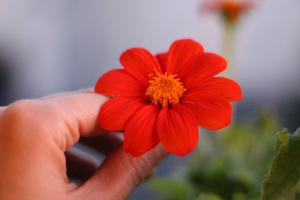
Tithonia bloom
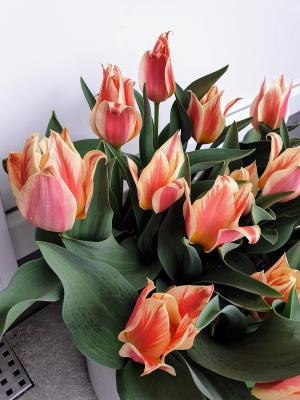
Tulips in April
The spring bulbs and radishes are definitely confidence boosters if you struggle with container gardening. Spring bulbs have plenty of stored energy to care for themselves. They’ll even grow in vases lined with pebbles provided they are watered. Their blooming success is based on the previous year’s growth. It’s generally a good rule to buy fresh bulbs for your containers, to insure you’ll have a display, then plant them out in the garden once they finished blooming.
The three dahlias were an odd mix of successes and failures. I potted two small balcony dahlias and one large dahlia. In the beginning of the year the small dahlias were under heavy attack by aphids and grew gnarled while the large dahlia grew healthy and strong without being invaded. I experienced dahlia aphid attacks in 2017, but this past season I resisted the urge to apply neem oil in order to observe them. My patience was rewarded when a ladybug decided to lay egg clusters on the underside of the leaves. For the next week before leaving for the States, I watched the murderous scene unfold as my larval army showed no mercy sucking the life out of the aphids. When I returned, the balcony dahlias had recovered producing small buds but the large white dahlia started to show signs of stress and nutrient deficiency. The pink balcony dahlia produced numerous blooms; the supposedly small yellow dahlia produced one large bloom; and the large white dahlia? Produced no blooms. Lesson learned, read the packages and use only dahlias intended for containers. I was naive to think I was experienced enough to grow a garden dahlia in a pot. In time, I think I will get there. For now, I’ll stick to smaller dahlias and store the tubers until next year.
The wallflowers in the large dahlia pot survived but also did not bloom. Since they are biennials, this is okay—I hope. I imagined a beautiful container display of large white dahlias and yellow wallflowers at the base. I thought the wallflowers would be in their blooming year but since the dahlia didn’t bloom, I’m glad the wallflowers didn’t either. After removing the dahlia tuber I replaced it with some fresh soil and a large foxglove, which leads into the next plant success: the foxgloves.
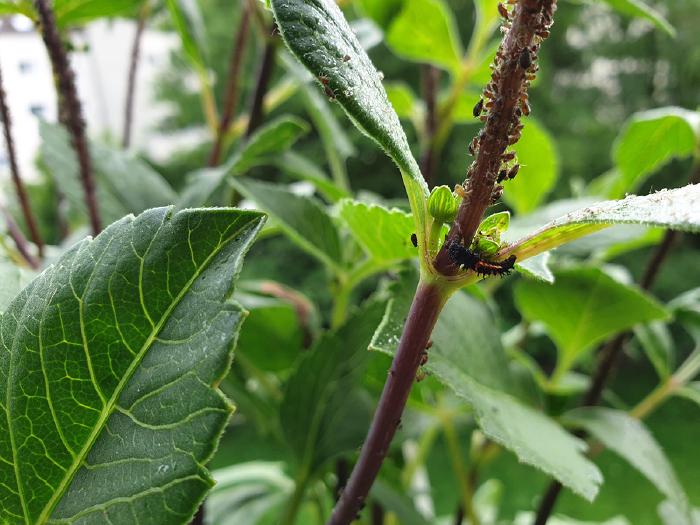
Orange and black ladybug larvae decimating aphids on dahlia stem.
I really enjoyed starting the foxgloves from seed. They taught me the importance of pricking out seedlings and make it clear when they’re unhappy. About ten plants made it to the Kleingarten but I kept two to observe how’d they do in pots. One was transplanted into a larger pot while the other was kept in a smaller pot. They really are very expressive in their needs no matter their age. The large foxglove was very happy and grew to the size of its container; it showed signs of wanting more space which I provided in the large white wallflower pot. The smaller one grew to the appropriate size of the pot but then paused its growth and showed signs of stress by lightning its leaf color, so I transplanted it into a larger container. I’m excited to see if they will bloom next year and how tall the spikes will be based on their life history.
I have no experience with strawberries but they seem to be tough plants. In early 2018 I bought two small strawberry plants intending to plant them immediately into prospective pots. One thing led to another and I left them in their original tiny pots that entire season. With the neglect they received of inconsistent watering, inconsistent lighting, and nonexistent fertilizing, naturally the plants showed signs of stress, with the leaves changing many shades of yellow, and red with no fruit. In early 2019, I finally planted them in larger pots thinking it would be a waste of soil, that they would surely die soon. They have made a comeback turning a healthy shade of green, producing new leaves and one is creating runners to produce more plants. I provided small pots for the runners to root into but we’ll see if they will produce any fruit next year.

Strawberry plant runners
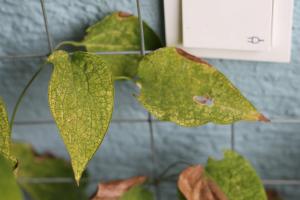
Clematis leaves showing signs of stress
One area that needs improvement is fertilizing. While I’m proud to have kept so much alive, I can tell that my plants weren’t 100% healthy, and that’s okay. I’ve proven to myself that I can container garden, now it’s just a matter of taking it to the next level and improving plant health. I suspect it was inconsistent fertilizing. I originally set out to fertilize once a week but sometimes that turned into two- to three-week spans (maybe even four weeks in August/ September). Plus, I’m not sure if I’m providing the correct fertilizer. The added guano probably helped until about mid-summer but I didn’t add more as a top dressing later in the season. For liquid fertilizer I used seaweed but I’ll have to do some research if this is providing enough potassium and calcium for fruit production. Learning more about fertilizers and fertilizing container plants will be a top priority this winter.
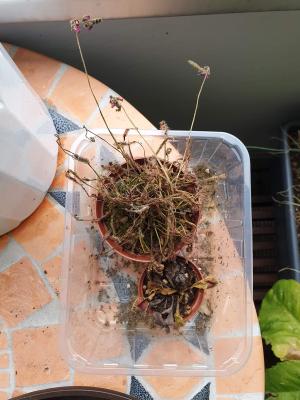
Carnivorous plants after European heatwave in July
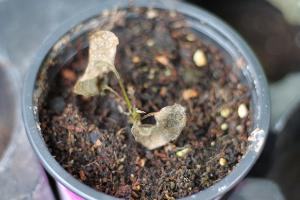
Overloved watered purple coneflower seedling
There were only two tragedies on the balcony this year, the carnivorous plants and the purple coneflower seedlings. Both groups died but valuable lessons were learned. The carnivorous plants were doing well out on the balcony but during the last week in my month-long trip to the States, they perished during the summer heatwave that rolled through Europe. Lesson learned, bring sensitive plants inside during long periods of travel. I assume the water they sat in got too hot during the heatwave, or they dried out too quickly between waterings during the heatwave. As for the coneflowers I waited too long to pot them on so they slowed their growth and after repotting overwatered them. Eleven out of 12 seedlings rotted, the last is still fighting for survival but hasn’t grown much. We’ll see if it survives winter.
Overall I’m proud, and surprised, that I managed to grow and keep the majority of plants alive this year. If you couldn’t tell by the length of this article, I had too many plants on the balcony (some of which I didn’t get to). In 2020, I’m going to attempt to pare down the variety of plants. I say “attempt” because, as any plant lover knows, it can be really difficult to do this, and we end up increasing our collections instead.
Next season I’ll try to focus my balcony garden efforts on herbs, leafy greens, and a few flowers. The 2017 Balkongarten was focused on herbs but we didn’t end up eating the bounty, just used a few sprigs here and there for cooking. But during our summer trip to the States in 2019, I acquired an inspiring pesto recipe book that teaches you how to get creative with summer harvests. Upon return we tested a few recipes supplementing with supermarket herbs but this isn’t the point of the book. The point is learning the ratios of pesto making so you can create a unique sauce based on what’s growing in your garden. And though space is at a premium, I will still care for some flowers; not only for their aesthetic value but mostly because I enjoy watching various insects visit them.
The main challenge for me will be maintaining the luscious green through proper watering and fertilizing to prevent the herbs from bolting. I’m up for the challenge. And worst-case scenario, I’ll supplement with herbs from the market again. What were your garden successes or failures in 2019 and what are your goals for next growing season? Any tips you can provide me? Let me know on Twitter @hereisthedill.

Cosmos
- Filed to:
- Balkongarten


